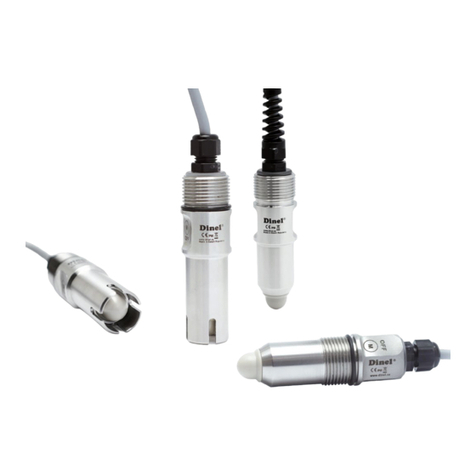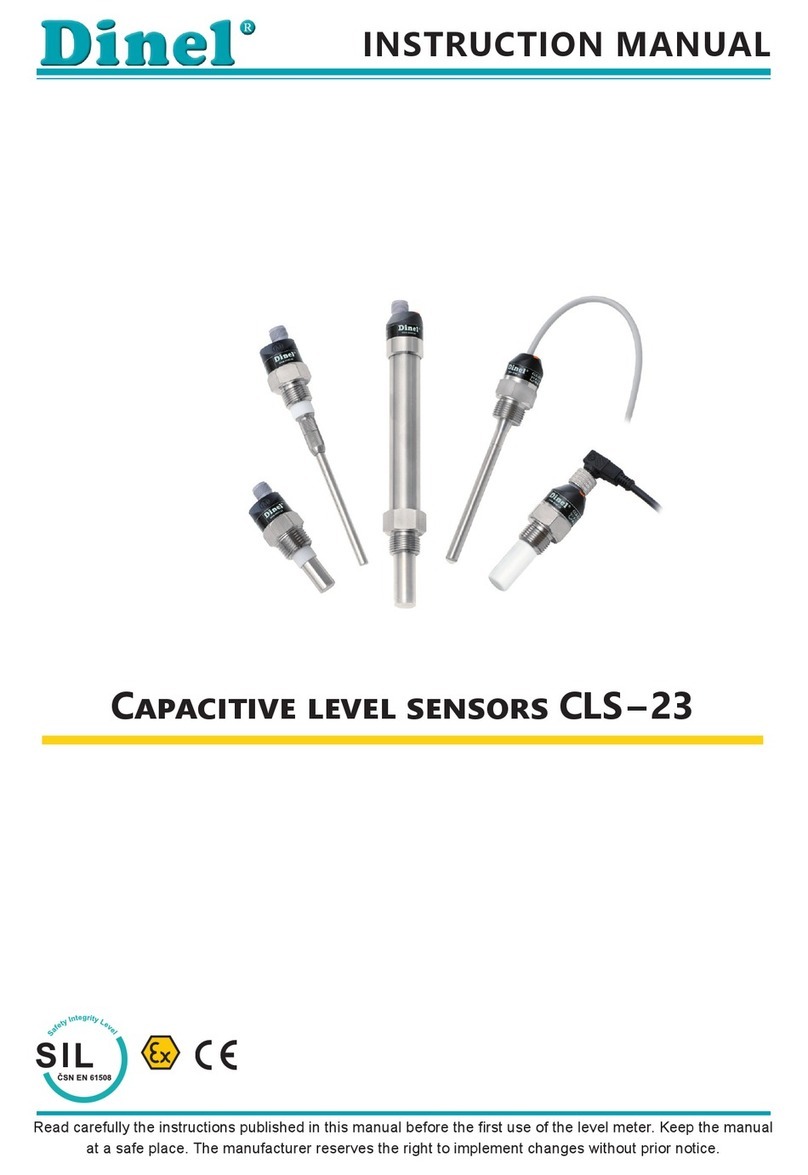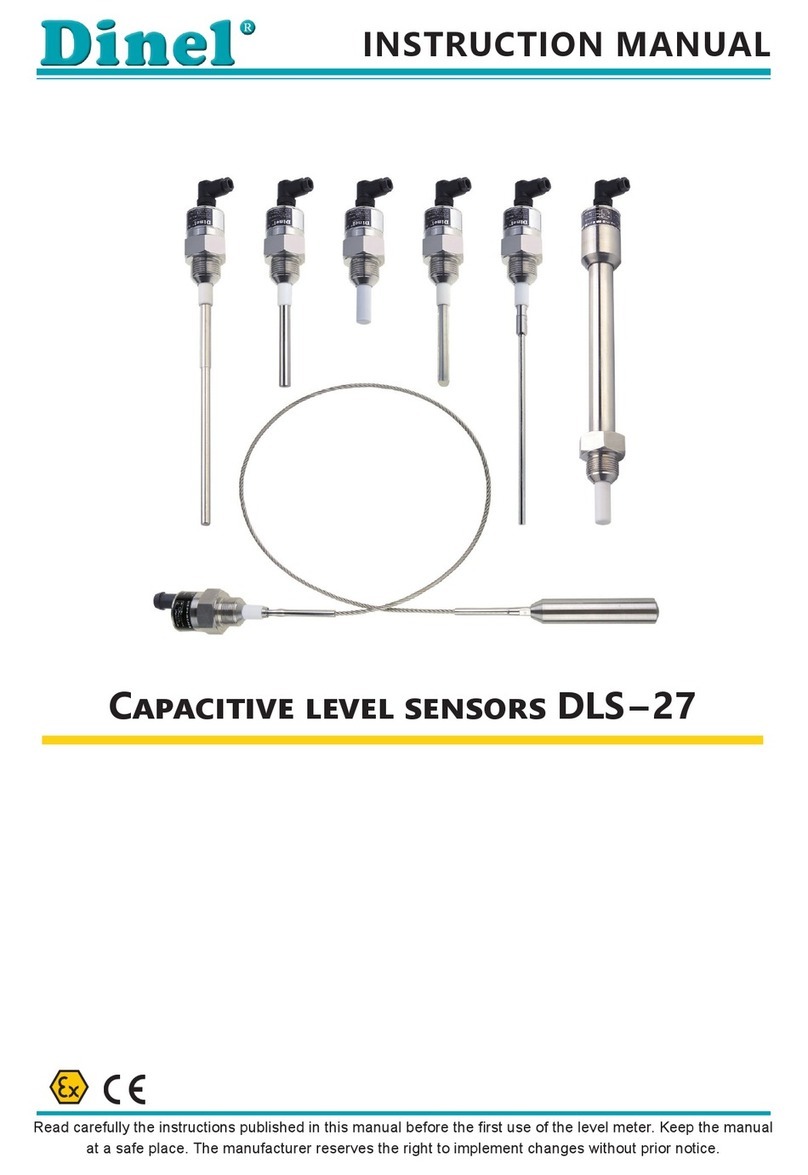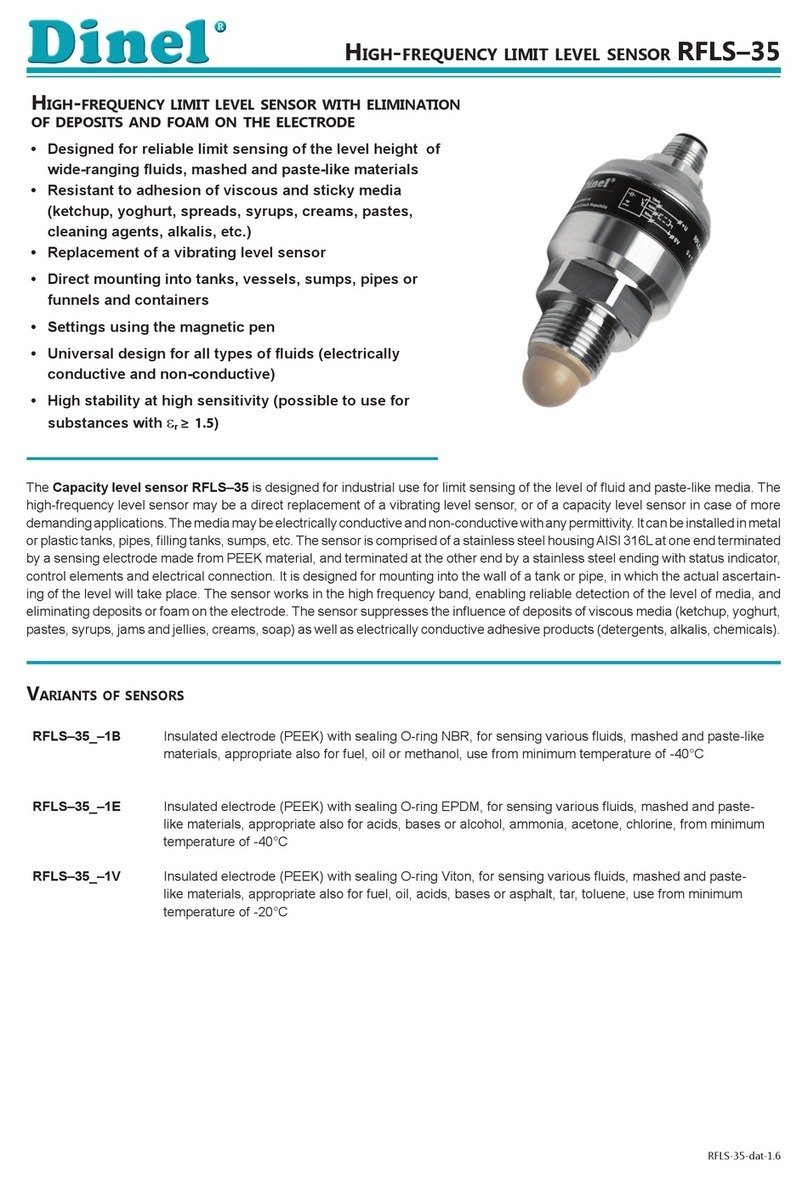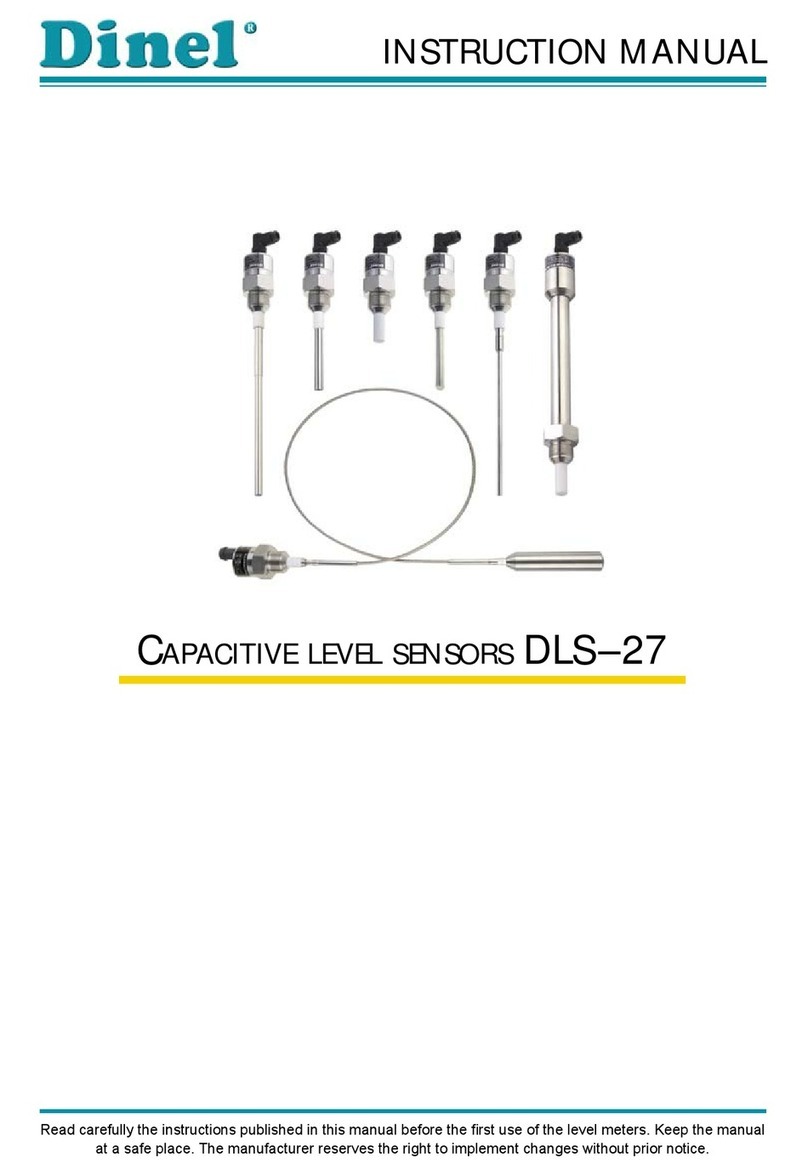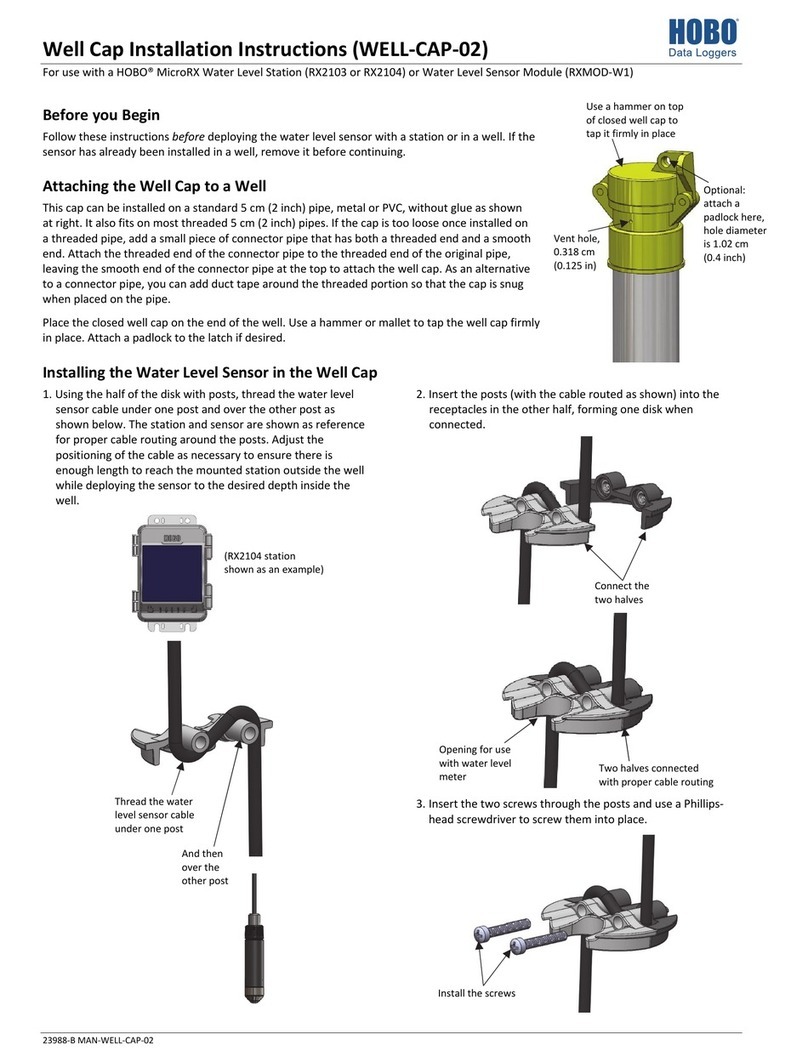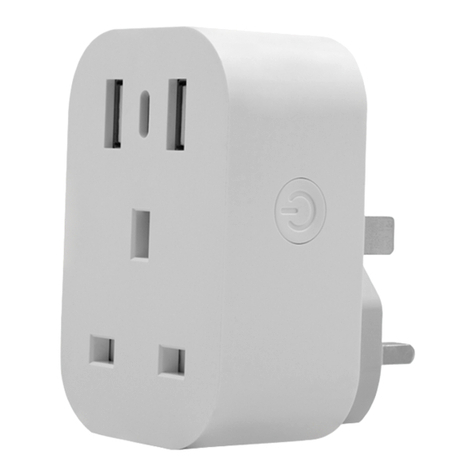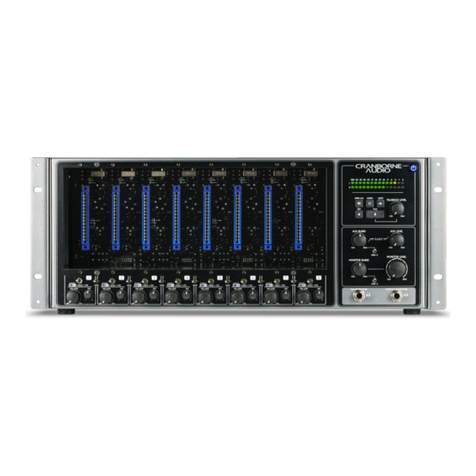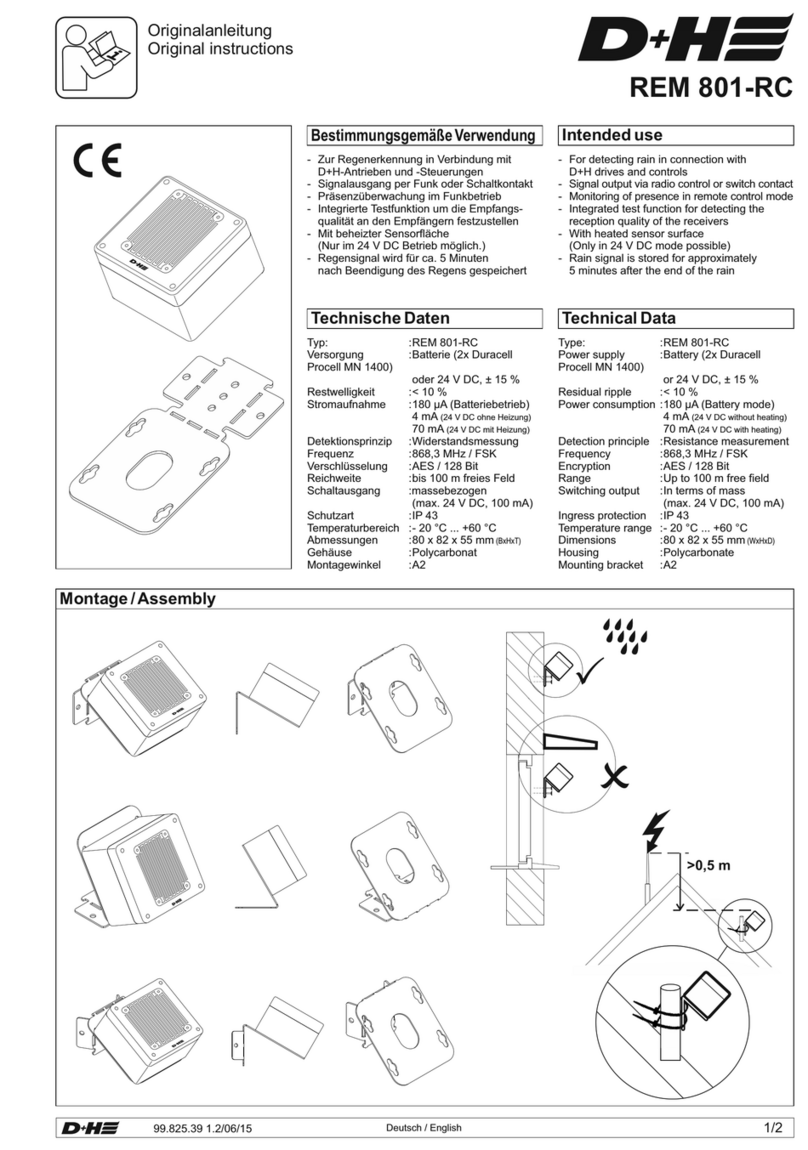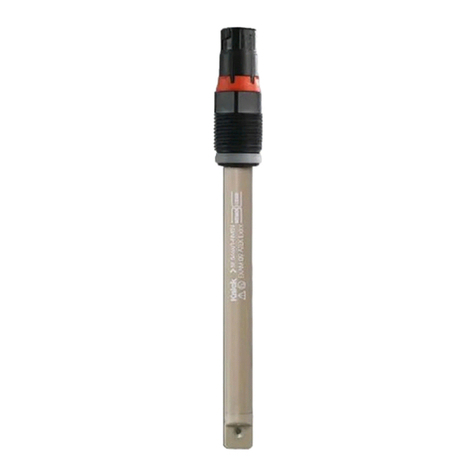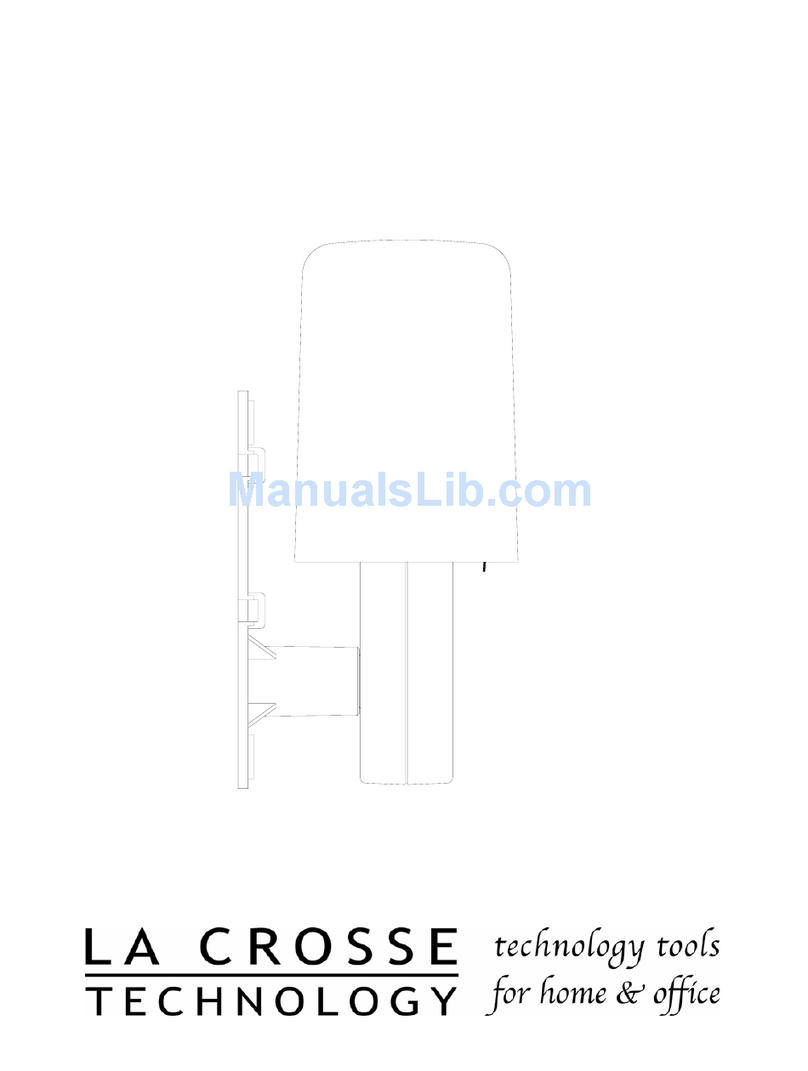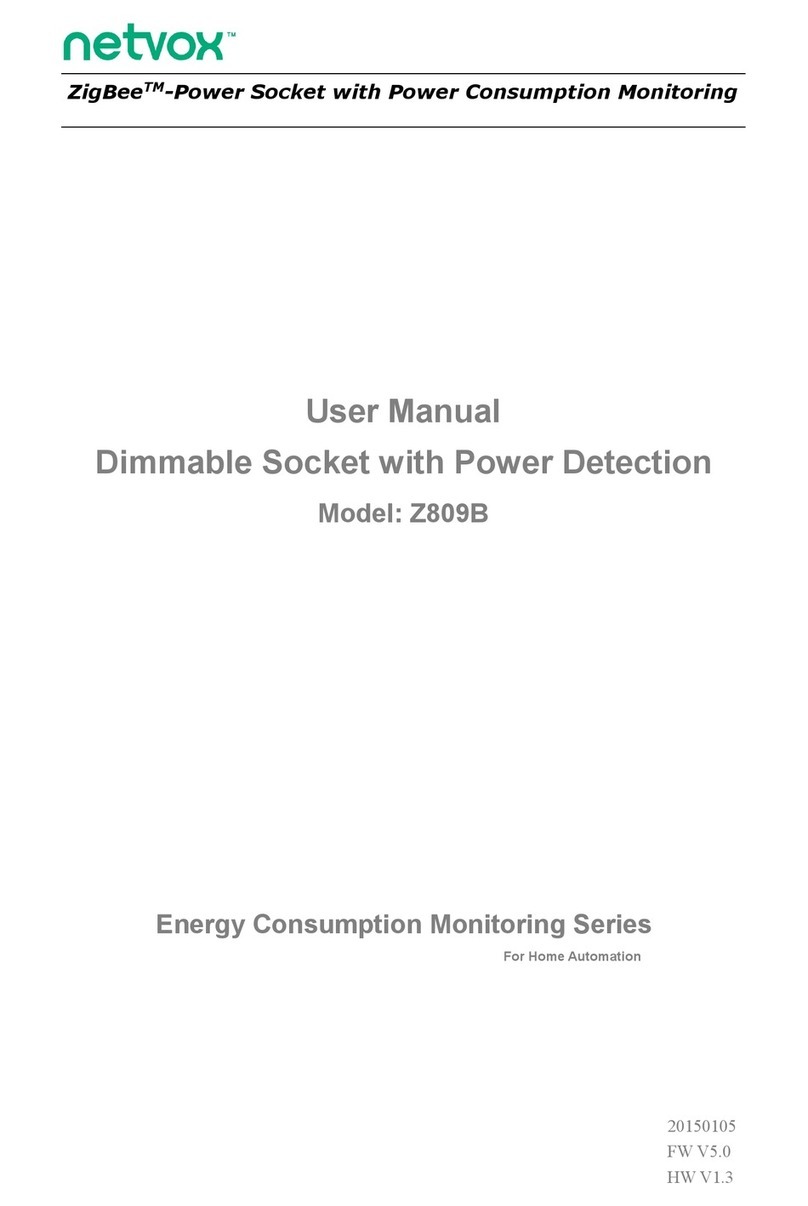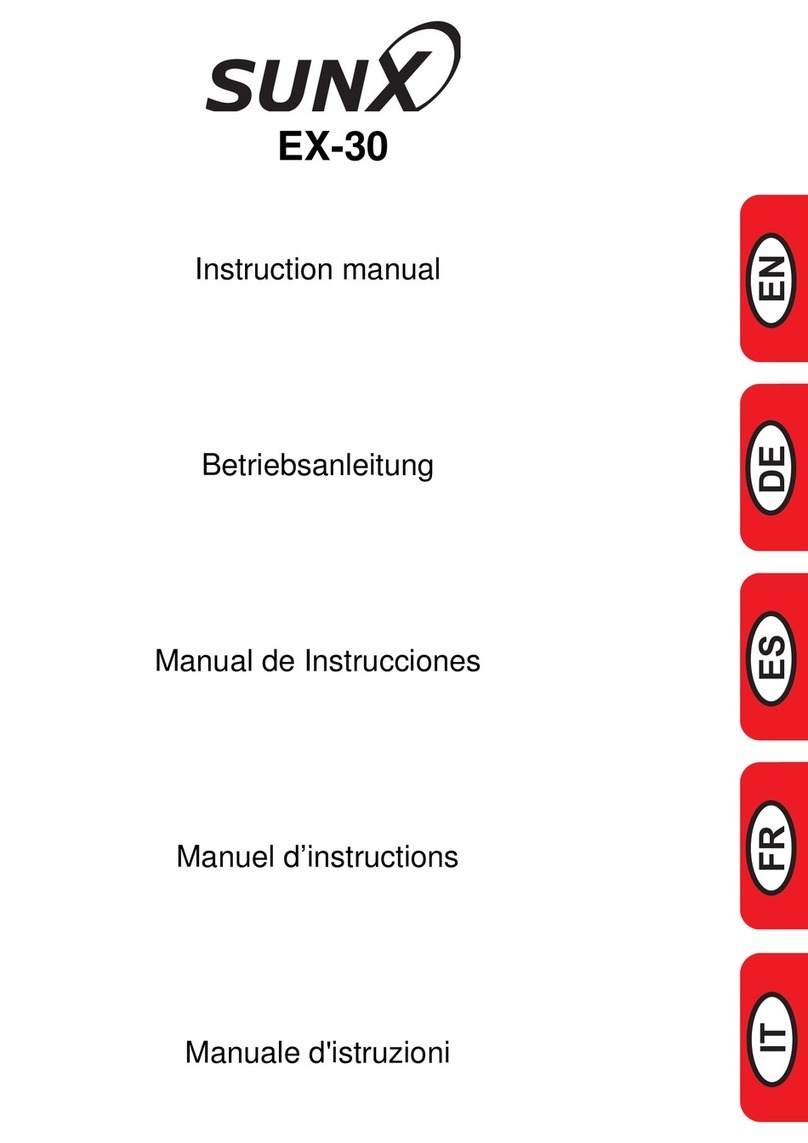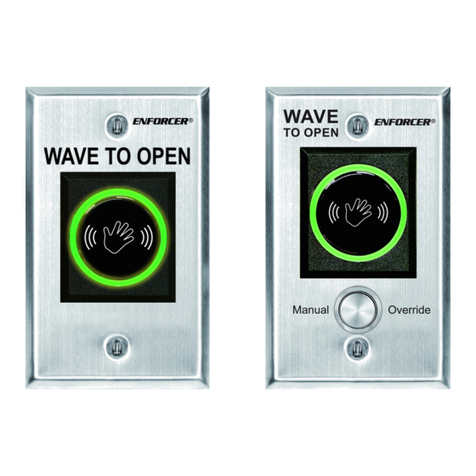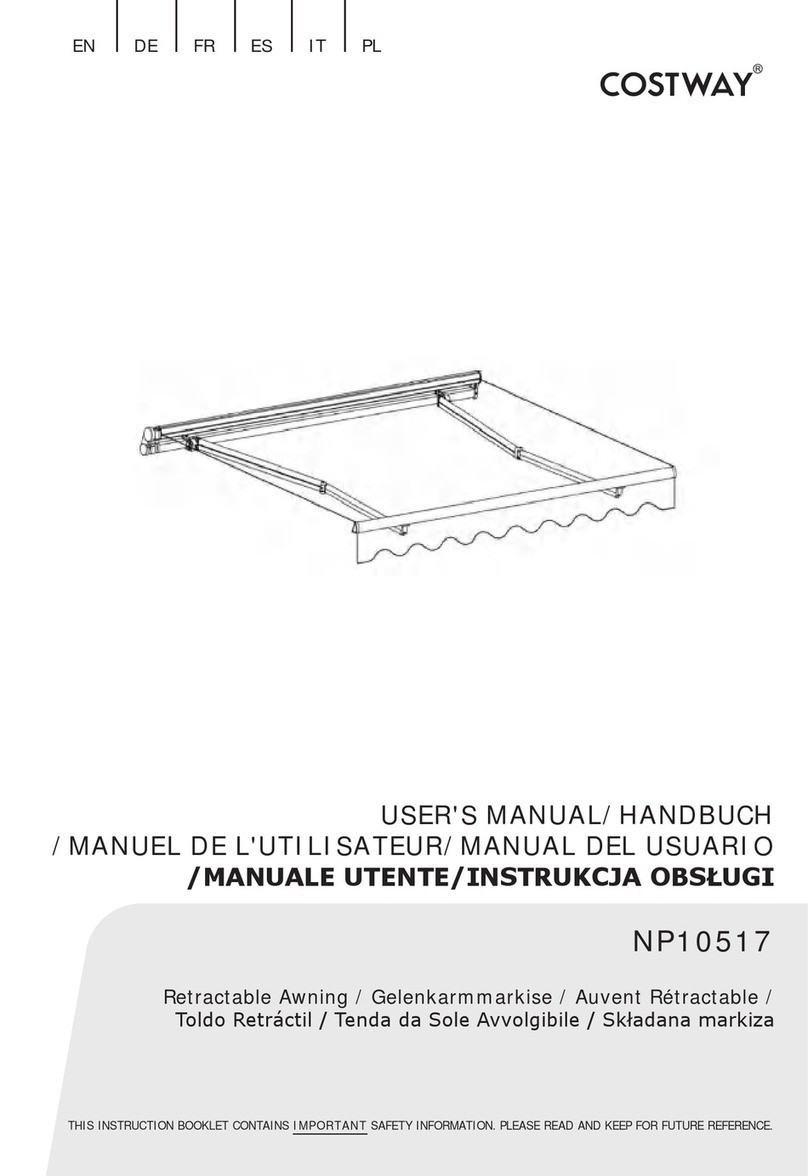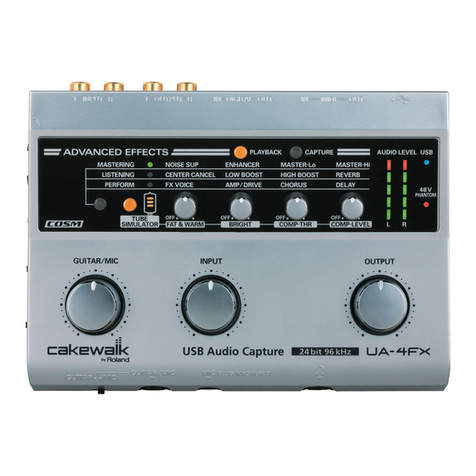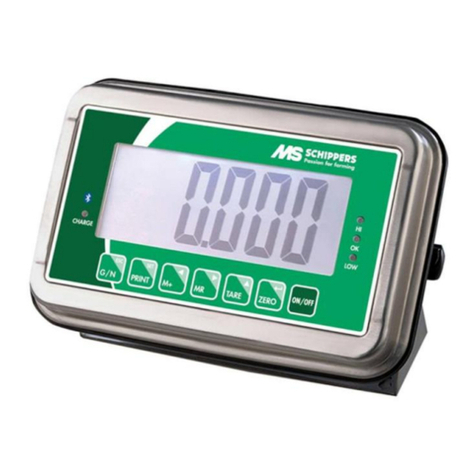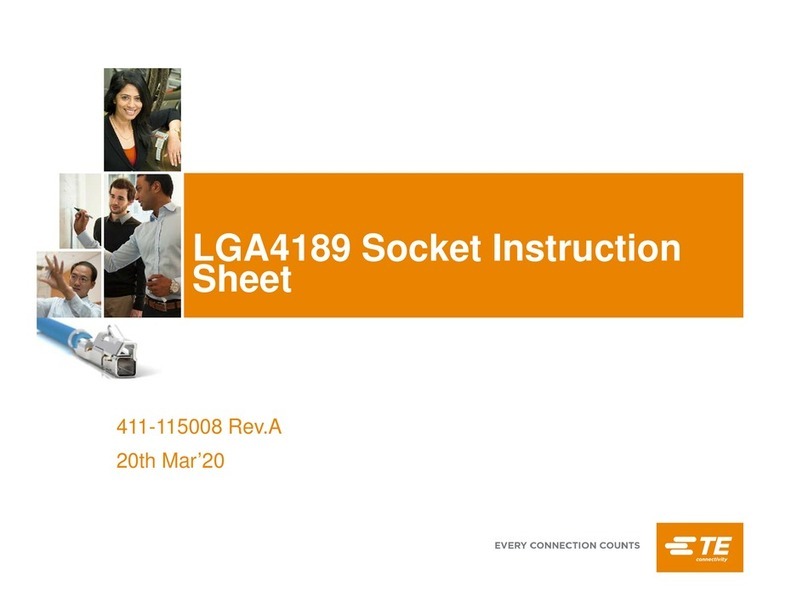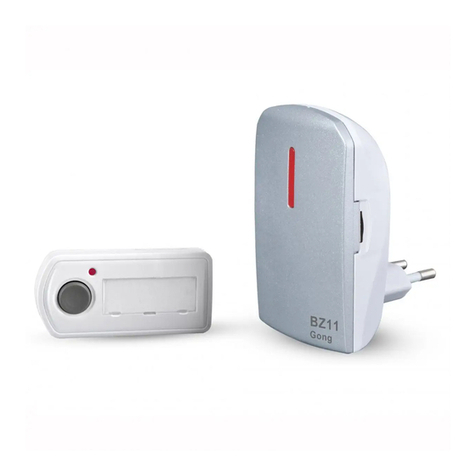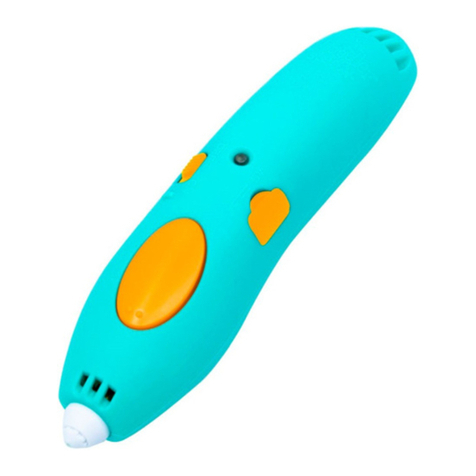Dinel RFLS-28 User manual

Read carefully the instructions published in this manual before the rst use of the level meter . Keep the manual
at a safe place. The manufacturer reserves the right to implement changes without prior notice.
High-frequency
limit level sensor RFLS – 28
INSTRUCTION MANUAL


1. Basic description ......................................................................................................................5
2. Variants of sensors ..................................................................................................................5
3. Dimensional drawings .............................................................................................................6
4. Installation and putting into operation .................................................................................7
5. Electrical connection ................................................................................................................7
6. Settings ......................................................................................................................................8
6. 1. Quick settings ..............................................................................................................8
6. 2. Basic settings ................................................................................................................9
6. 3. Settings “Medium window” - media resolution function ..................................... 10
6. 4. Setting using the W programming wire ................................................................. 11
7. Setting elements ................................................................................................................... 15
8. Function and status indication ............................................................................................ 16
9. Mechanical mounting ........................................................................................................... 16
10. Sensor variant with output "PD" with Diagnostic ............................................................. 17
10.1. Diagnostic modes ..................................................................................................... 17
10.2. Evaluation unit .......................................................................................................... 18
10.3. Function and status indication with diagnostic ..................................................... 18
11. Order code ............................................................................................................................. 19
12. Accessories ............................................................................................................................ 20
13. Safety, protection and compatibility .................................................................................. 21
14. Functional safety ................................................................................................................... 21
15. Use, manipulation, and maintenance ................................................................................ 21
16. Putting out of operation or disposal .................................................................................. 22
17. General conditions and warranty ....................................................................................... 23
18. Marking of labels ................................................................................................................... 23
19. Technicalspecications........................................................................................................ 24
20. Packing, shipping and storage ............................................................................................ 26
CONTENTS

RFLS–28 © Dinel, s.r.o.
4
All operations described in this instruction manual have to be carried out by trained personnel
or by an accredited person only. Warranty and post warranty service must be exclusively
carried out by the manufacturer.
Improper use, installation or settings of the sensor can lead to crashes in the application
(overlling the tank or damage to system components).
The manufacturer is not responsible for improper use, loss of work caused by either direct
or indirect damage, and for expenses incurred at the time of installation or during the period
of use of the sensor.
To ensure maximum safety of control processes, we have dened the following safety instructions and
information. Each instruction is labelled with the appropriate pictogram.
Alert, warning, danger
This symbol informs you about particularly important instructions for installation and opera-
tion of equipment or dangerous situations that may occur during the installation and op-
eration. Not observing these instructions may cause disturbance, damage or destruction of
equipment or may cause injury.
Information
This symbol indicates particularly important characteristics of the device.
Note
This symbol indicates helpful additional information.
Used symbols
Safety

5
© Dinel, s.r.o. RFLS–28
The high-frequency level sensor RFLS–28 is designed for industrial use for limit sensing of the
level of liquid and paste-like media. The high-frequency level sensor may be a direct replacement
of a vibrating level sensor, or of a capacitive level sensor in case of more demanding applications.
The media may be electrically conductive or non-conductive with any permittivity. It can be installed
in metal or plastic tanks, pipes, lling tanks, sumps, etc. using the TN-28 extension tube, or similar.
The sensor works in the high frequency band, enabling reliable detection of the level of media, and
eliminating deposits or foam on the electrode. The sensor suppresses the inuence of deposits of
viscous media (ketchup, yoghurt, pastes, syrups, jams and jellies, creams, soap) as well as electri-
cally conductive adhesive products (detergents, lye, chemicals).
The sensor can be set by applying a magnetic pen to sensitive surfaces, or by means of a program-
ming wire (variant RFLS-28 _-_-_- PD -_- MW). For sensors with the possibility of remote param-
eterization, only basic settings (resolution of two interfaces) can be performed. A special evaluation
unit SSU-1212-AD must be used for remote parameterization of the sensor.
The sensor can be set up by applying a magnetic pen to sensitive spots.
• simple sensing of the presence of the medium (medium / air)
• resolution of the interface of two media (medium / medium), e.g. water / oil
• selective resolution of a specic medium (Medium window function), the function can distin-
guish e.g. oil from water and air, detect only beer foam and ignore beer and air, etc.
The sensor is made from a stainless steel housing at one end terminated by a sensing electrode,
and terminated at the other end and by an enclosure with a status indicator, control elements and
electrical connection. The setting elements are on the sides of the sensor. The sensors are manu-
factured only for use in non-explosive areas.
1 . Basic description
2 . Variants of sensors
VARIANTS
name minimum
temperature type
RFLS–28_–1B from -40°C O-ring NBR, for sensing various liquids, mashed
and paste-like materials, appropriate also for oil
RFLS–28_–10B from -40°C with protective crown, O-ring NBR, for sensing various liquids,
mashed and paste-like materials, appropriate also for oil
RFLS–28_–1E from -40°C O-ring EPDM, for sensing various liquids, mashed
and paste-like materials, appropriate also for acids or bases
RFLS–28_–10E from -40°C With protective crown, O-ring EPDM, for sensing various liquids,
mashed and paste-like materials, appropriate also for acids or bases
RFLS–28_–1V from -20°C O-ring FPM (Viton), for sensing various liquids, mashed and paste-like
materials, appropriate also for oil, acids, bases or asphalt and tar
RFLS–28_–10V from -20°C
with protective crown, O-ring FPM (Viton), for sensing various liquids,
mashed and paste-like materials, appropriate also for oil, acids,
bases or asphalt and tar

RFLS–28 © Dinel, s.r.o.
6
3 . Dimensional drawings
RFLS–28_–1_–G¾ RFLS–28_–10_–G¾ Extension tube TN-28-P***
12,5
71 42,5approx.
18,5
14,6
⌀
24
⌀
28
⌀
G¾
OK 22
O-ring
4x2 (B, E or V)
~ 2 *
~ 10 **
OK 22
24⌀
28
⌀
12,5
71
73,5
18,5
42,5approx.
G
¾
O-ring
4x2 (B, E or V)
L50 ... L3000*
55
80
28
~ 2
46
12
11
4x
64
~ 2
cable gland
(type B, V or H)
is part of TN-28
24x2 O-ring
(B, E or V)
is part of TN-28
24x2 O-ring
(B, E or V)
is part of TN-28
Ø
L50 ... L3000*
~ 2
28
~ 2
12
24x2 O-ring
(B, E or V)
is part of TN-28
Ø
cable gland
(type B, V or H)
is part of TN-28
24x2 O-ring
(B, E or V)
is part of TN-28
~ 2
28
L50 ... L3000*
G1"
~ 2
~ 16
14
17
24x2 O-ring
(B, E or V)
is part of TN-28
Ø
cable gland
(type B, V or H)
is part of TN-28
24x2 O-ring
(B, E or V)
is part of TN-28
The switching point is the same for both variants of sensors.
* Typical switching point position for water (factory default).
** Typical switching point position for oil.
*** Extension tube variants:
P - ange (ingure),
Z - thread G1“, Cl - Tri-Clamp
see the accessories data sheet for
TN-28 extension tube
Variant "B"
with standard
cable gland
Variant “V” with plastic
cable gland with spiral
relief - in the case of increased
mechanical wear on the cable.
Spiral relief
Variant “H” with cable
gland for protecting hoses
- for use in an outdoor area
or in area with high humidity.
protecting hose
(ø 13 mm)

7
© Dinel, s.r.o. RFLS–28
This procedure has the following three steps:
• Mechanical assembly see Chapter 9
• Electrical connection see Chapter 5
• Settings see Chapter 6
4 . Installation and putting into operation
5 . Electrical connection
A sensor with PNP output can be loaded only by resistive or inductive load. The capacitative loads
and low resistance loads (bulb) are evaluated by the sensor as a short circuit.
Connection diagrams are listed in Figure below.
The RFLS-28 sensors are connected to evaluation units permanently by a PVC cable.
Electrical connection can only be made when de-energized!
The power supply must be designed as a stabilized source of low safe voltage with galvanic
isolation. If a switched power supply is used, its design must effectively suppress common
mode interference. If the switched power supply is equipped with a PE protective terminal,
it must be earthed without fail!
If the level meter (sensor) is to be installed in an outdoor environment more than 20 m from
an outdoor switchboard or an enclosed building, the electrical supply to the level meter
(sensor) must be supplemented with suitable overvoltage protection.
In case of a strong environmental electromagnetic interference, common routing of the signal
cable with power cable or in case of more than 30 m length, we recommend using a shielded
cable and grounding the shielding on the power source side.
Legend:
BK – black
BN – brown
BU – blue
Legend:
BK – black
BN – brown
BU – blue
WH – white
P
WH
Fig. 1: Sensor connection with PNP output, without programming cable
Fig. 2: Sensor connection with PNP output, with programming cable

RFLS–28 © Dinel, s.r.o.
8
6 . Settings
The settings must be made before installing the sensor in the TN-28 tubular extender..
When setting up the RFLS-28 sensor, it is necessary to monitor the signalling of both LEDs, there-
fore it is necessary to make settings before installing the sensor in the tank.
• Make the electrical connection of the sensor - see chapter 5
• In the case of simple detection of non-adhesive medium, it is possible to use
the Quick settings according to chap. 6.1. Otherwise, it is necessary to make settings
with the presence of medium.
• Prepare the measured medium in the auxiliary vessel.
• If you want to detect the presence of a medium (medium / air) or to detect the interface
of two dierent media (medium / medium), eg water / oil, follow chap. 6.2 Basic settings
• If you want to selectively detect a specic medium, follow chap. 6.3 Settings "Medium
window" mode.
6.1. Quick settings
This mode is only suitable for verifying the sensor before start-up if the measured medium is not
available.
a) Setting the mode O (without the possibility of using the medium)
1. The sensor is turned with the measuring electrode into the free space.
2. Apply the magnetic pen for 5 - 10 seconds to the sensitive spot of the sensor (at rst both
LEDs light up, after approx. 3 seconds the orange LED ashes 3 times, and after another
approx. 2 seconds the orange LED ashes again 3 times - now you can remove the magnetic
pen. The sensor is now set to the mode O (closes when submerged).
b) Setting the mode C (it is open when submerged)
1. The sensor is turned with the measuring electrode into the free space.
2. Apply the magnetic pen for 5 - 10 seconds to the sensitive spot of the sensor (at rst both
LEDs light up, after approx. 3 seconds the orange LED ashes 3 times, and after another
approx. 2 seconds the orange LED ashes again 3 times - now you can remove the magnetic
pen. The sensor is now set to the mode C (opens when submerged).
If no other agreement the mode “O” is set on all sensors straight from the factory.
When using the function "Quick Settings", the sensor does not eliminate the presence
of deposits and foam on the electrode. The manufacturer recommends performing Basic
Settings as soon as possible.

9
© Dinel, s.r.o. RFLS–28
6. 2. Basic settings
For setting the sensitivity and switching mode, where it is possible to submerge the sensor in or
remove it from the medium. When using this setting, the sensor eliminates the presence of deposits
and foam on the electrode.
a) Setting the mode O (it is closed when submerged)
1. Immerse the sensor electrode in the medium to be measured (in case of interface detection of
two media, place the electrode into the lower medium).
2. Apply the magnetic pen for 2 - 4 seconds to the sensitive spot of the sensor (until both
LEDs shine) and then remove the magnetic pen. Settings are conrmed by three ashes of the
orange LED.
3. Pull the sensor out of the media. Leave possible deposits on the electrode (in case of interface
detection, place the electrode to the upper medium).
4. Apply the magnetic pen for 2 - 4 seconds to the sensitive spot of the sensor (until both
LEDs shine) and then remove the magnetic pen. Settings are conrmed by three ashes of the
orange LED.
5. Check the state of indicators:
• If the orange LED is dark and the green LED ashes, the sensor is correctly set.
• If the orange and green LEDs ash alternatively, the sensor did not recognize the limits for
closing and opening. In this case, nd out whether the minimum and maximum levels are
not set too close to one another.
b) Setting the mode C (it is open when submerged)
1. Immerse the sensor electrode in the medium to be measured (in case of interface detection of
two media, place the electrode into the lower medium).
2. Apply the magnetic pen for 2 - 4 seconds to the sensitive spot of the sensor (until both
LEDs shine) and then remove the magnetic pen. Settings are conrmed by three ashes of the
orange LED.
3. Pull the sensor out of the media. Leave possible deposits on the electrode (in case of interface
detection of two media, place the electrode to the upper medium).
4. Apply the magnetic pen for 2 - 4 seconds to the sensitive spot of the sensor (until both
LEDs shine) and then remove the magnetic pen. Settings are conrmed by three ashes of the
orange LED.
5. Check the state of indicators:
• If the orange LED shines and the green LED ashes, the sensor is correctly set.
• If the orange and green LEDs ash alternatively, the sensor did not recognize the limits for
closing and opening. In this case, nd out whether the minimum and maximum levels are not
set too close to one another and possibly repeat the settings.
For safety reasons, we recommend setting the mode “O” for level sensing (the sensor closes when
submerged). A faulty sensor or wiring will take effect here in the same way as level emergency
conditionsbyopeningthe sensor.Analogously, for the maximum levelitisrecommendedtoset the mode
“C” (the sensor opens when submerged).

RFLS–28 © Dinel, s.r.o.
10
6. 3. Settings “Medium window” - media resolution function
The sensor can also be used to distinguish a specic medium from others – using the "Medium
window" function. E.g. the sensor can distinguish oil from water and air, detect only beer foam and
ignore beer and air, etc. To set the sensitivity and switching mode for the required medium. With
this setting, the sensor does not react to being submerged in a medium with a dierent permittivity.
Orange LED
dark
Orange LED
dark Orange LED
shining
Fig. 2: Mode “Medium window” - only detection of required medium:
(e.g.: only beer foam, beer and air are ignored)
a) Setting the mode O (sensor closes when submerged in the required medium)
1. Immerse the sensor electrode in the medium to be measured.
2. Apply the magnetic pen for at least 10 seconds to the sensitive spot of the sensor (at rst
both LEDs light up, after approx. 3 seconds the orange LED ashes 3 times, and after another
approx. 2 seconds the orange LED ashes again 3 times - now you can remove the magnetic
pen.
The sensor is now set to mode O (closes when submerged in the required medium).
3. Check the state of indicators:
• If the orange LED shines and the green LED ashes, the sensor is correctly set.
b) Setting the mode C (sensor opens when submerged in the required medium)
1. Immerse the sensor electrode in the medium to be measured.
2. Apply the magnetic pen for at least 10 seconds to the sensitive spot of the sensor (at rst
both LEDs light up, after approx. 3 seconds the orange LED ashes 3 times, and after another
approx. 2 seconds the orange LED ashes again 3 times - now you can remove the magnetic
pen.
The sensor is now set to mode C (opens when submerged in the required medium).
3. Check the state of indicators:
• If the orange LED is dark and the green LED ashes, the sensor is correctly set.

11
© Dinel, s.r.o. RFLS–28
6.4. Setting using the W programming wire
With the variants provided with the remote parametrization option (RFLS-28_-_-_-PD_MW), it is
possible to set the sensor using the W programming wire, or a special evaluation unit SSU-1212-
AD, respectively. This unit is equipped with a contact (terminal No. 7) to connect the programming
wire allowing the basic settings of the sensor to be performed. Quick settings as per paragraph
6.1.1 or the setting of the “Medium window” mode as per paragraph 6.1.3 is not possible.
6.4.1. Evaluation units SSU-1212-AD
The unit has one input for the connection of the operating sensor (marked as IN, terminal No. 3).
The operating sensor enables the control of the operating relay (terminals 14, 15, 16). The unit is
tted with the diagnostic function monitoring the correct operation of the connected sensor, and
the remote parametrization function for the connected sensor using the W programming wire. The
programming wire is connected to the terminal marked as P (terminal No. 7).
Front panels and numbering of terminals
Indication LED - SSU-1212-AD
Green “POWER”
• light – connection of the 230 VAC power supply, correct function
• dark – failure (short circuit on the power supply terminals)
Orange “OUT”
• light – output relay activated, contacts 15, 16 closed
• dark – output relay deactivated, contacts 14, 15 closed
• – sensor setting acknowledgement
Red “ALARM”
• light – emergency relay deactivated, contacts 11, 12 open
• dark – emergency relay activated, contacts 11, 12 closed
Description of setting elements
by the “P / N” switch
• P position – the unit reacts to the current entering the input terminal (No. 3) for the PNP-type
sensors
N position – the unit reacts to current leaving the input terminal (No. 3)
for the NPN-type, “S”, and Namur sensors, or those with voltage-free contact output
by the “SET CH OFF / ON” switch
• OFF position– the setting function of the sensor connected to the IN terminal (No. 3)
deactivated
• ON position – the setting function of the sensor connected to the IN terminal (No. 3) activated
SET CH
SET
SETTING
POWER
SSU-1212-AD
OUT ALARM
7DIAGNOSTIC
PULSES
CH
PROG
BK
SSU-1212-AD
WH
BU
BN

RFLS–28 © Dinel, s.r.o.
12
by the “SET OFF / ON” switch
• OFF position – setting the sensor opening
• ON position – setting the sensor closing
by the “BLK OFF / ON” switch
• OFF position – status of the emergency relay has no impact on the status of the operating
relay
• ON position – emergency status of the emergency relay locks the operation of the operating
relay and deactivates it – contacts 15, 16 open
6.4.2 Connecting the sensor to the evaluation unit
6.4.3 Basic settings of the sensor using the SSU-1212-AD unit
The function suitable for setting the sensor to simple sensing or resolution of the interface of two
media (see p. 4). For setting the sensitivity and switching mode, where it is possible to submerge
the sensor in or remove it from the medium. When using this setting, the sensor eliminates the pres-
ence of deposits and foam on the electrode.
a) Setting the “O” mode (closes when submerged)
1. Immerse the sensor electrode in the medium to be measured.
2. Switch the SET CH a SET switches to the ON position
3. Press the setting button (SETTING). Settings are conrmed by three ashes of the orange
LED.
SET CH
SET
SETTING
POWER
SSU-1212-AD
OUT ALARM
7
DIAGNOSTIC
PULSES
CH
PROG
BK
SSU-1212-AD
WH
BU
BN
PNP output type sensor connection
+U sensors terminal No. 5 or 6
Q output of the sensor terminal No. 3
0 V of the sensor terminal No. 1 or 2
programming wire terminal No. 7
Legend
BK black
WH white
BU blue
BN brown

13
© Dinel, s.r.o. RFLS–28
4. Pull the sensor out of the media. Leave possible deposits on the electrode.
5. Switch the SET switch to the OFF position
6. Press the setting button (SETTING). Settings are conrmed by three ashes of the orange
LED.
7. Check the state of the ALARM indicator. If the red LED is not ashing, the sensor is set cor-
rectly. If it is ashing, the sensor is set incorrectly. Repeat the setting.
b) Setting the c mode (opens when submerged)
1. Immerse the sensor electrode in the medium to be measured.
2. Switch the SET CH switch to the ON position and the SET switch to the OFF position
3. Press the setting button (SETTING). Settings are conrmed by three ashes of the orange
LED.
4. Pull the sensor out of the media. Leave possible deposits on the electrode.
5. Switch the SET switch to the ON position
6. Press the setting button (SETTING). Settings are conrmed by three ashes of the orange
LED.
7. Check the state of the ALARM indicator. If the red LED is not ashing, the sensor is set cor-
rectly. If it is ashing, the sensor is set incorrectly. Repeat the setting.

RFLS–28 © Dinel, s.r.o.
14
For safety reasons, for scanning min. level, we recommend you to use the "O" mode setting (sensor closes when
submerged). A faulty sensor or wiring will take eect here in the same way as level emergency conditions by opening
the sensor. Analogously for the max. level, we recommend you to set the "C" mode (sensor opens when submerged).
level state mode output state Orange LED
maximum level sensing
CCLOSED
(shining)
COPEN
(dark)
level state mode output state Orange LED
minimum level sensing
OCLOSED
(shining)
OOPEN
(dark)
Setting modes
The sensor can be set to normally closed "O-mode" or to normally open "C-mode" switch types.

15
© Dinel, s.r.o. RFLS–28
7. Setting elements
Fig. 3: RFLS-28 sensor setting up
The RFLS-28 switch can be set in two ways, namely using the magnetic pen M (variants RFLS-28_-
_-_-P-_-M, RFLS-28_-_-_-PD-_-M a RFLS-28_-_-_-PD-_-MW) or the programming wire W(vari-
ant RFLS-28_-_-_-PD_MW). Remote parametrization only allows basic settings (interface of two
media).
For variants without the remote parametrization option, setting must be provided before the sensor
is installed in the tank. This setting is performed by placing the magnetic pen on sensitive spots
marked as M /ON or M /OFF located on the sensor enclosure in the following modes:
• Quick settings - the user does not know precisely to what medium the sensor should be set,
he only wants to put the sensor into operation (usually upon receiving it) and check to see if
the sensor is generally functional.
• Basic settings - the user has the medium available and can perform on the sensor its ooding
and drainage.
• Medium window settings - the user has the medium available and can perform on the sensor
its ooding and drainage.
M
OFF
M
ON
Orange LED
upper view
Green LED
Sensitive spot

RFLS–28 © Dinel, s.r.o.
16
9 . Mechanical mounting
The RFLS-28 level sensor is designed for vertical installation in tanks and reservoirs.
With the TN-28 extension tube, which is available in three process connection variants (ange, G1”
thread or TriClamp), it can be extended to the required length.
• Before installing the sensor in the tank, it is rst necessary to set it - see Chapter 8
• If the sensor is set up, you will proceed to its installation in the TN-28 extension tube.
• First, the cable is passed through the extension tube and then the RFLS-28 sensor is screwed
into the pipe.
• The complete assembly with the selected process connection is attached to the tank.
Fig. 4: Installation of the level meter out of the reach of lling ow
8 . Function and status indication
LED indicator colour function
"RUN" green
Measuring function indication
– (approx. 0.4 s) – correct function of level detection
dark – incorrect installation or malfunction.
– error in settings
simultaneous shine of green and orange LED – when applying the
mag. pen, when the setting is conrmed
"STATE" orange
Settings indication
permanent shine – the sensor is closed
dark – the sensor is open
– settings conrmed
– error in settings
simultaneous shine of green and orange LED – when applying the
mag. pen, when the setting is conrmed

17
© Dinel, s.r.o. RFLS–28
When installing the sensor in a metal tank or reservoir, the housing is not necessary to be grounded
separately.
In the case of the use for an aggressive medium is necessary to prove the chemical
compatibility of the materials, from which the sensor is made (see Tab. Used materials on p.
18). Any chemical damage is not covered by the warranty.
10 . Sensor variant with output "PD" with Diagnostic
10.1. Diagnostic modes
The diagnostic has one mode of error-free operation and three modes indicating a malfunction or
incorrect setting.
10.1.1. Correct measurement
INDICATION: - green LED ashes (approx. 0.4 s)
- orange LED: when the output is closed, the LED shines
when the output is open, the LED is dark
OUTPUT: a 300 μs wide pulse with a period of 30 ms is generated into the output signal
SENSOR STATUS: the diagnostic does not indicate any problem, the measuring curve and the
sensor settings are correct
10.1.2. Incorrect setting
INDICATION: alternating ashing green and orange LEDs
OUTPUT: a 300 μs wide pulse with a period of 20 ms is generated into the output signal
SENSOR STATUS: the measuring curve is OK, but the sensor setting is incorrect (decision levels
are close to each other)
The sensor type RFLS-35_-_-_-PD has a diagnostic built in its rmware with which it monitors its
functional reliability. In order for the diagnostic to be active, i.e. the error notication to be indicated
even if the control or output circuit is not functional, the microprocessor generates short pulses to
the output signal, the so-called diagnostic pulses. Negative pulses are generated when the output is
closed and positive pulses are generated when the output is open. This ensures faultless operation
of all HW and SW components of the sensor.

RFLS–28 © Dinel, s.r.o.
18
10.2. Evaluation unit
A special unit SSU-1212-D is designed for the evaluation of diagnostic modes, which can evaluate
the pulses generated by the sensor. It does not matter what state the sensor output is in (closed or
open). Based on the period of the generated pulse, the unit determines in which diagnostic mode
the sensor is and communicates information to the user.
10.1.3. Incorrect measurement
INDICATION: - green LED is dark
- orange LED: in the event of closed output the LED shines with periodic dim-
ming (0.1 s)
in the event of open output the LED is dark with periodic lighting
up (0.1 s)
OUTPUT: a pulse with a width of 300 us with a period of 10 ms is generated into the output signal
SENSOR STATUS: the sensor setting is OK, but the diagnostic indicates a problem with the meas-
uring curve, which can be caused by a failure of any element of the sensor
10.1.4. Another failure of sensor
INDICATION: the state of both LEDs cannot be specied, as their function may be aected by a
control circuit error
OUTPUT: the sensor does not generate any diagnostic pulses in the output signal
SENSOR STATUS: either it is a fault in the control circuit or a failure in the output part of the elec-
trical circuit and these faults can be diagnosed only by a special version of the
SSU-1212-D
10.3. Function and status indication with diagnostic
LED indicator colour function
"RUN" green
Measuring function indication
– (approx. 0.4 s) – correct function of level detection
dark – incorrect installation or malfunction.
– error in settings
simultaneous shine of green and orange LED – when applying the
mag. pen, when the setting is conrmed
"STATE" orange
Settings indication
permanent shine – the sensor is closed
dark – the sensor is open
– settings conrmed
– error in settings
simultaneous shine of green and orange LED – when applying the
mag. pen, when the setting is conrmed
periodic extiction (0,1 s) in closed mode - diagnosed function error
periodic lighting (0,1 s) in open mode - diagnosed function error

19
© Dinel, s.r.o. RFLS–28
11 . Order code
ORDER CODE
RFLS-28
PERFORMANCE
Nnon-explosive areas
ELECTRODE TYPE
1B insulated electrode (PEEK, NBR O-ring)
10B insulated electrode (PEEK, NBR O-ring) with protective crown
1E insulated electrode (PEEK, EPDM O-ring)
10E insulated electrode (PEEK, EPDM O-ring) with protective crown
1V insulated electrode (PEEK, FPM O-ring (Viton))
10V insulated electrode (PEEK, FPM O-ring (Viton)) with protective crown
PROCESS CONNECTION
G¾pipethreadG ¾”
OUTPUT OF TYPE
PPNP (open collector)
PD PNP (open collector) with diagnostic1)
TYPE OF ELECTRICAL CONNECTION
Bstandard plastic cable gland
Vstandard plastic cable gland with spiral
Hplastic cable gland for protecting hose
SETTING
Bmagnetic pen
MW programming wire and magnetic pen
CABLE
Kcable length in m
RFLS-28 N - 1B - G¾- P - B - M - K AVAILABLE VARIANT
OF THE PRODUCT
1) The evaluation units SSU-1212-D and SSU-1212-AD are used to evaluate the diagnostic signal. For the
variant with the possibility of remote parameterization, it is necessary to use the evaluation unit SSU-1212-AD.
These units will go on sale in the rst half of 2021.

RFLS–28 © Dinel, s.r.o.
20
12 . Accessories
magnetic pen (1 pc)
included
in the
price
MP-8
O-ring
(NBR, EPDM, FPM/
Viton), (1 pc)
included
in the
price
extension tube at extra
cost
TN-28-P (ange)
TN-28-Z (G1“
thread)
TN-28-Cl (Tri-
Clamp)
cable over 2 m at extra
cost
protecting hose (for
cable gland H)
at extra
cost
Table of contents
Other Dinel Accessories manuals
